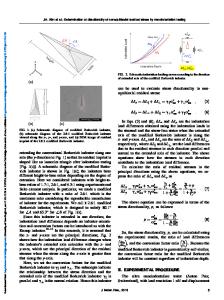Multiple-Frequency Nanoindentation Testing
- PDF / 181,383 Bytes
- 6 Pages / 612 x 792 pts (letter) Page_size
- 83 Downloads / 364 Views
R4.3.1
Multiple-Frequency Nanoindentation Testing A.C. Fischer-Cripps CSIRO Division of Industrial Physics PO Box 218 Lindfield NSW 2070 Australia ABSTRACT This paper describes a new method of dynamic nanoindentation testing whereby, instead of the imposition of a single sinusoidal modulation onto the driving force signal, a multiplefrequency modulation is applied and a Fourier analysis used to extract frequency-dependent mechanical properties. The instrument response is cancelled by the use of a reference transfer function using an equalization process. The present work gives details of the method and presents some example measurements. INTRODUCTION In general, the mechanical responses of materials lie somewhere between predominantly solidlike or fluid-like behaviour. Solid-like, or elastic materials store energy under deformation, and upon removal of stress, the material returns to its original state. Viscous materials dissipate energy during deformation and upon removal of stress, the material remains in its deformed state. Materials with a combined solid-like and viscous-like properties are said to be viscoelastic. Viscoelastic materials are characterized by the storage modulus G' (which measures the solid-like properties) and the loss modulus G" (which measures the fluid like properties). Quantitatively, we express the complex modulus G* as: G * = G '+iG"
(1)
The ratio of the storage modulus to the loss modulus is expressed as the loss factor, tan δ: tan δ =
G" G'
(2)
Tan δ > 1 indicates a predominantly viscous or fluid-like behaviour whereas tan δ < 1 indicates a predominantly solid-like response. In conventional dynamic nanoindentation testing, a sinusoidal modulation of the load signal is applied during acquisition of the quasi-static load-displacement curve. The storage and loss moduli are found from the real and imaginary parts of the complex transfer function TF: TFre = G ' =
Po cos δ ho
TFim = G" =
Po sin δ ho
(3)
R4.3.2
where Po and ho are the amplitudes of the load and displacement signals and δ is the phase angle between the two signals. The real part of the transfer function, G', represents the contact stiffness S which, for a viscoelastic material, is dependent on frequency. Following the usual unloading analysis procedure [1], the reduced specimen modulus E' is thus expressed in terms of the area of contact, where, setting G' to be equivalent to S, we have: E ' (ω) = =
π Po cos φ 2 A ho π 2 A
(4)
TFre
The viscous nature of the specimen material is quantified by the loss modulus G" and, for an indentation test, is expressed as a specimen loss modulus E": E" (ω) = =
π Po sin φ 2 A ho π 2 A
(5)
TFim
MULTIPLE FREQUENCIES The analysis described above is usually applied to single-frequency oscillations of the indenter in nanoindentation testing [2]. However, it is of significant practical interest to measure viscoelastic properties of materials over a range of frequencies since the properties are often dependent on frequency. Rather than performing a time-consuming series of single-f
Data Loading...










